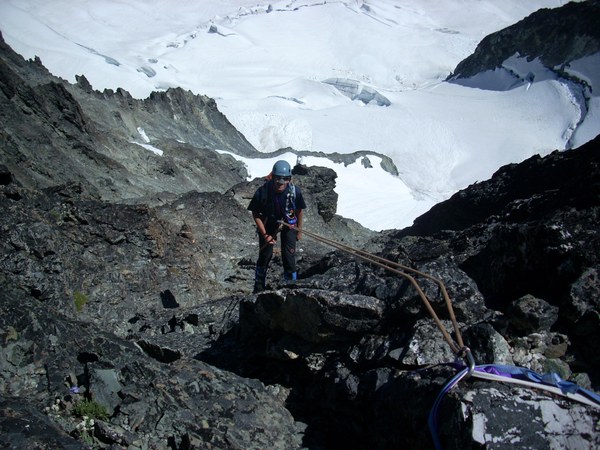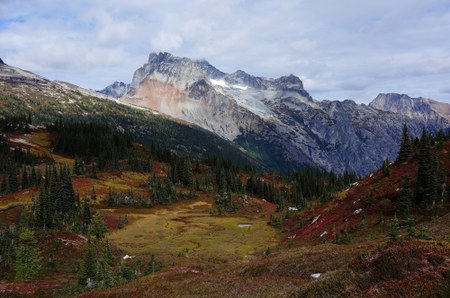
Parental foolishness knows no bounds. When our son Ben was just an infant, we took him to Bonanza in an ill-advised attempt to climb the peak. Ben was an absolute terror and completely unmanageable at high camp – in other words, a classic 11-month-old, and we had to turn around.
My second failed attempt on Bonanza came 13 years later. With lightning striking the summit just as we left high camp, Bonanza was just not the right choice that day either.
Yet my hunger for the peak and my desire to share my love of mountaineering with my family remained. Which begs the question: How do you share that thing you love most, with the people you love most, when that thing entails such wonderful wildness and risk?
An “ascent of character”
At 9,511 feet, Bonanza is the highest non-volcanic peak in the State of Washington. Its ascent requires substantial maneuvering across a large and deep glacier and extended rock-climbing high above. The elevation gain from trailhead to summit is over 6,100 feet – like climbing out of the Grand Canyon, only steeper – and mostly on glacial ice.
What does an objective, authoritative source like Fred Beckey say about Bonanza? After a detailed description of the route and its challenges (e.g., climbing or rappelling through waterfalls), he adds: “The complexity of the mountain, loose rock, and attendant route-finding problems render the ascent of Bonanza very questionable in anything but settled weather. Its sheer size and height above the protection of the timberline zone, and its treacherous couloirs and snow conditions, make it an ascent of character... In many respects, Bonanza has something of the quality of the large peaks in the Alps and Canadian Rockies... 12 to 16 hours round-trip is common; a very early start is wise.“ [Cascade Alpine Guide, Climbing and High Routes, Vol. 2, 3rd ed. Fred Beckey; Mountaineers Books].
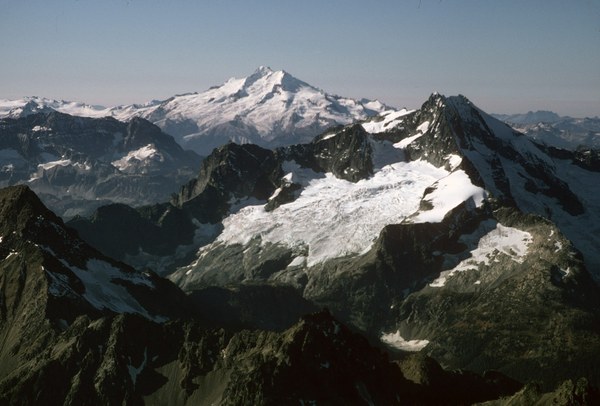 Bonanza Peak from the east, with the arrow-shaped "thumb" on its left flank shining in the sunlight, and Glacier Peak along the horizon. Photo by the U.S. Forest Service.
Bonanza Peak from the east, with the arrow-shaped "thumb" on its left flank shining in the sunlight, and Glacier Peak along the horizon. Photo by the U.S. Forest Service.
Successful summits on Bonanza are not common. Although I had heard of many climbers who took aim at Bonanza, back then I'd never encountered anyone who had actually summited. In my three visits to base camp at Lake Holden I saw no other humans, and two visits to high camp at Holden Pass revealed no other tents or climbers. The summit register itself testifies convincingly to a summit seldom visited.
In short, Bonanza offers a special set of climbing challenges in a wild and remote alpine setting that instills love-of-place, and which had earned it a spot high on my "someday" list for years.
A life of preparation
In 2010, the timing felt right for another go at Bonanza. Ben was 23 now – a much more manageable age at high camp – and happy to take on this challenge with me. In preparation, we’d researched the route, assembled the right gear, and honed skills on earlier climbs.
Learning to climb is different in a father-and-son (or daughter) setting. While I try to emphasize over-communication on trips I lead with peers (you have to say something to overcome climbers’ typical reticence about sharing uncomfortable information), with your own family I think you need to let the journey be the instructor whenever you can. In his high school years, it was ascents of Mt. Daniel, Mt. Baring, Mt. Ruth, Sahale Peak, Mt. Adams, and then Mt. Rainier. In each case, I was taking my son back to a place I’d enjoyed before, and using each peak to increase the risk and runouts incrementally. When appropriate, I encouraged him to take the lead with me or with his friends who came along.
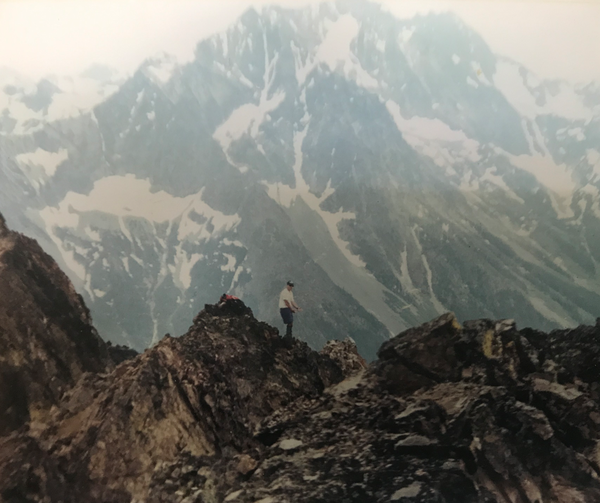 Bill on the Martin Peak summit ridge, July 2000. Bonanza peak dominates the background. Photo by Karl Forsgaard.
Bill on the Martin Peak summit ridge, July 2000. Bonanza peak dominates the background. Photo by Karl Forsgaard.
When he went back east to college, he extended his own rock climbing expertise well beyond mine, and became the technically stronger rope-mate in many respects. Soon we’d complete the Ptarmigan Traverse together, and be lucky enough to take extended climbing trips on some of the high- elevation glaciated peaks in the Cordillera Blanca in Peru and Ecuador. The guides we hired for international trips provided Ben with broader experience climbing with others, and allowed him to hear new safety talks and their particular emphases on how to have a successful climb.
By the time of the 2010 Bonanza trip, Ben and I had completed some 30 climbs together. He had become the best of company on a climbing trip, always ready and psyched to go, and super positive while bringing a measured and analytic response to the challenges that arise in alpine mountaineering.
A trip into the unknown
Starting for Bonanza, we backpack our way up the valley and turn off the main trail toward Holden Lake. Before the lake appears, the forest disappears. I see waves of trees demolished and catawampus as only a high-energy avalanche can accomplish, and tree trunks piled like twizzle sticks, but more broken up and scattered with rocks and mud. The debris zone looks to be at least 3/4 of a mile across. We lose the trail completely for an hour or more, finally finding a faint path past the lake headed up the slope. We work hard pushing our packs uphill to 6,200 feet, where we see heather and a landscape that drops away magnificently to the north. This must be the pass.
Arising early on summit day, we find a goat path heading due west across heather-covered slopes leading up toward the glacier. The heather disappears, and soon we’re standing in an expanse of rock slabs with streams running across. The glacier buried these slabs beneath heavy ice for the last 20,000 years, but the ice's recent retreat has left this rock mantle shining with water streaming from the glacial underbelly.
We cross the streams and proceed westerly up, hugging the base of the cliffs to the north and searching for an angled slope from which we can mount the snout of the glacier. The snow has melted away, exposing a moat separating us from the base of the cliff next to the glacier. Such moats are omnipresent in the North Cascades – bring up the topic and many climbers have stories about a fall or a rescue involving moats. I angle toward the narrowest part, hoping we can find a spot to jump across onto the rockface. The perimeter of the snow patch seems solid but requires further investigation for thinning edges. I probe. The ice axe pokes a hole through a thin lip of snow, revealing darkness and unbounded space below. I know we must jump from where I am standing. The leap works, and Ben duplicates it precisely. We are on rock with a route to scramble up onto the glacier.
I confess that I have come to like glacier travel. A symmetry to the icescape appeals to me deeply: crevasses open in (somewhat) regular patterns, and groups of crevasses often sit in parallel, particularly where the rock underneath steepens and the ice accelerates down slope. Like rapids in a river, just moving in a graceful slow motion that offers a kind of cinematography.
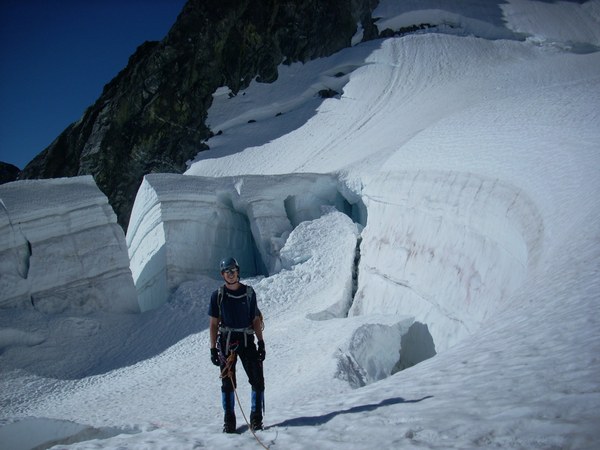 BEN CHAPMAN BY A CREVASSE BELOW THE UPPER GLACIER “THUMB.” PHOTO BY BILL CHAPMAN.
BEN CHAPMAN BY A CREVASSE BELOW THE UPPER GLACIER “THUMB.” PHOTO BY BILL CHAPMAN.
We ascend the corridor recommended by Beckey along the northern rim of the glacier. It’s mostly free of crevasses and we make good time. While we climb, I discuss the subtleties of the route with Ben. The conversation serves to double check the route for safety and assure we don't get too comfortable. One mistake is too many; we have to be right in distinguishing each snow bridge from the crevasses they cover, and we need to find the gateway to the upper glacier "thumb." Preferably quickly.
Climbing in North Cascades is different from sport routes in rock gyms or bolted routes in popular areas. Finding the climbing route can sometimes be the most serious challenge. We try to read the glacier’s rhythms carefully.
We complete the mile ascending west on the glacier. Now we’re up against the headwall and the rock reaches 100 stories into the sky above us. We discern a route onto the "thumb" identified as part of the upper glacier, locate the bergschrund that separates it from the cliff face above, and imagine we can see a place where the ‘schrund narrows and perhaps can be crossed?
We commit the shape of our intended route to memory and head up.
The ‘schrund does separate ice from rock, and the moat it creates is both deep and wide. We will not be jumping across. Front-pointing briefly on our crampons and using the ice axes like ice hammers, we climb down into and then up the rock on the other side. We feel our way up, looking for the most climbable aspects, seeing impressive verticality around us but also seeing slanting gullies breaking through the cliffs and allowing us a route through the cliff faces. We pass an old sling still fixed to an anchor of rock, and later another, and one more higher up as well — each of them suggesting this might be the right route!
We climb straight to the top of the ridge, and then follow the knife-edged skyline south toward the true peak. False summits and steep segments are mentioned, but the rock is relatively solid, only chossy in places. It's all within a range of straightforward Class 4 or 5 climbing.
We climb until there is nothing higher. A thousand feet above the glacier and more than a vertical mile above treeline, we can see ridge after ridge of snow-covered mountains in every direction. Only wildness fills our landscape. For me, exertion intensifies the feeling of uniting with this landscape and with the mountain.
We savor the summit and the sun. The beauty is spectacular, and I don’t have words to describe how I feel to share this incredible experience with my son.
A test of agility
The summit is only halfway, and too soon it is time to head down. We downclimb the ridgeline, rig an anchor, and Ben leans over the thousand-foot cliff to start the first of six rappels back.
Ben Chapman beginning his rappel down. Photo by Bill Chapman.
Almost back to high camp, we have only to jump the moat, glissade the snow patch, and cross the granite slabs below us. At dawn this morning, we had picked our way carefully across these streams and are now standing face-to-face with the reality of the heat of the day. The water’s flow has increased by incredible volume and velocity – now we are facing not streams, but roaring waterfalls.
Standing at 7,000 feet, we watch as the upper lip of a waterfall cascades into the lake far below. Looking across the stream flowing toward the waterfall, I review the sequence of jumps, skips, hops, and stops in my mind, visualizing the sequence. I double-check my view of the dimples mid-stream where I think the rock will hold me well.
I can’t wait any longer, and I execute the sequence. To my relief, it works out fine.
I look back at Only Son Ben and remember too many things: watching seven year old Ben climb trees and wondering if he understands the consequences; creating and insisting on a parental rule about managing your own risks early on; joyously, but not without nerves, jumping from a rock shelf across a small crevasse onto an angled snow slope during the Ptarmigan Traverse and then hearing Ben tell me it was hard for him to watch me do it. Yet each of these experiences helped him understand what it was like for me to watch him embrace risk too.
I watch Ben closely as he studies the challenge before him. I wonder for an instant whether he is comfortable with the awkward, booby-trapped test of agility before him. My confidence in this 23-year-old and his skill set is comprehensive and complete, but the stakes on this crossing are as high as they get.
Then he’s in motion, crossing methodically and deliberately, on balance throughout. With a deep, grateful breath, we walk away from the waterfall and safely home toward camp.
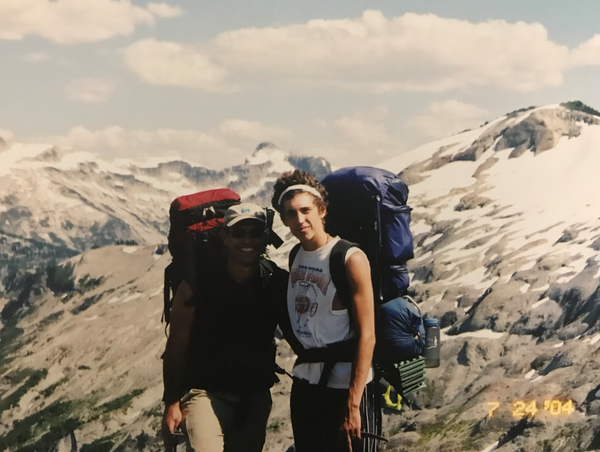 Bill and Ben on Hannegan Peak with Ruth Mountain in the background, July 2004. Photo by Bill Chapman.
Bill and Ben on Hannegan Peak with Ruth Mountain in the background, July 2004. Photo by Bill Chapman.
A life worth living
Having lived through this and many an adventure together, I can say it’s harder to watch the one you love execute a dangerous task than to do it yourself. We manage risks the best we can, usually agreeing, but there is give-and-take in this regard. It's important for climbers, and all the more for a father-son team, to watch, study, and assess risk, then talk it over to be sure you’re on the exact same page.
I climb seeking places of beauty. I climb in search of solitude and freedom and to indulge my wandering spirit. I climb to explore what's around the corner and learn what's in the blank space between. I climb because I love the feeling of moving fast and light and because the physical exertion liberates me in nature and infuses my body with energy and joy.
I climb because it draws me closer to those I climb with by revealing character, and engendering trust and reliance in ways that matter most. I climb to see ecology manifested, geology on display, and the charismatic megafauna in their own element. I climb because climbing high mountains is the metaphor people around the world reach for first when trying to explain the greatest challenges and most exhilarating moments of their lives.
Sharing this life with Ben was a risk. But I’m glad my son now knows these joys and feelings too — and that more adventures are in front of us, as long as we can manage the risk.
Lead image of Bonanza Peak from the trail between Upper and Lower Lyman Lake. Photo by Martin Bravenboer.
This article originally appeared in our fall 2022 issue of Mountaineer magazine. To view the original article in magazine form and read more stories from our publication, visit our magazine archive.
 Bill Chapman
Bill Chapman
